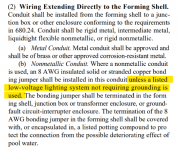Probably not.Any sense in pulling it out now to take a look in the mean time?
Where is the junction box?Need to know what kind of cord length then as that is a big part of it.
Probably not.Any sense in pulling it out now to take a look in the mean time?
Where is the junction box?Need to know what kind of cord length then as that is a big part of it.
Standard Pentair "Amerilte." They now use a stamped stainless-steel faceplate and a different clamp to hold it together.Ah, well I thought I needed to post a picture of the light out of the water.
View attachment 468350
It's a very standard boring looking light. I see the screw up at the top, didnt consider it being a latch at the bottom. So I guess just go unscrew that top part and see if I can pull it out?
As for the "cold", it's Florida, so it's in the 70s during the day here. Nothing is frozen or really cold right now. 50s at night if that's considered too cold to do this.
Any sense in pulling it out now to take a look in the mean time?
That will be worse than having the breaker tripped all the time?No, leave the light in as pulling the light out may give you a leak.
Amerilite - yes. If the light breaker powers nothing else, leave it tripped, won't hurt a thing. If there is something else on the circuit (there shouldn't be) don't turn the light on. If anything else is on that circuit besides a light it need to be moved to its own circuit.That will be worse than having the breaker tripped all the time?
Should be warm enough in March to get this going then.
The closest replacement part would be one of these:
??






It's straight 120, there is no low voltage anything here. No transformers that I know of. Maybe there is a junction box? I am not actually sure were the conduit sits to go to the light. It was all designed and installed before low voltage was a thing. The pump and salt water are powered by a feed that goes out of the left of the breaker box. I am not actually sure where there are two conduits leading out of the bottom. The whole system is a pump, a salt water system, and a light. Nothing else.You can use any large Pentair light.
You can go to LED in white or color.
Can you see a junction box anywhere?
Do you have a transformer?
Is it 12 volts or 120 volts?




Possibly.Could the other side go back to the switch?
If you're comfortable working with electricity, then I would open it up to see what's what.Since the breaker is off can I just go open this up and see what's in there?
That looks like it's probably the light cord.
If you can verify that the #8 bonding jumper is secured in the niche, then you can probably go with a new 120 volt light.
If there is an issue with the #8 green bonding jumper/supplemental ground, then you might want to consider going with a 12 volt light.
You can install a low voltage transformer near the subpanel.
The junction box should be a "Listed" junction box specifically labeled for Pool and Spa use.
How far is it from the subpanel to the light?
Is there any sign of a different junction box anywhere?
Can you verify that the wires go to the light and the light switch?
Yes.1) To verify the bonding I need to take the light out and look, right?
The conduit should be watertight and the conduit will have water in it up to the same level as the pool.Behind the light itself is the conduit itself sealed or something that I need to know about? What is back there to prevent the water from leaking out? In the guide video they just pull it through with the string and that was it. So I am assuming its engineered somehow to handle all this water?

